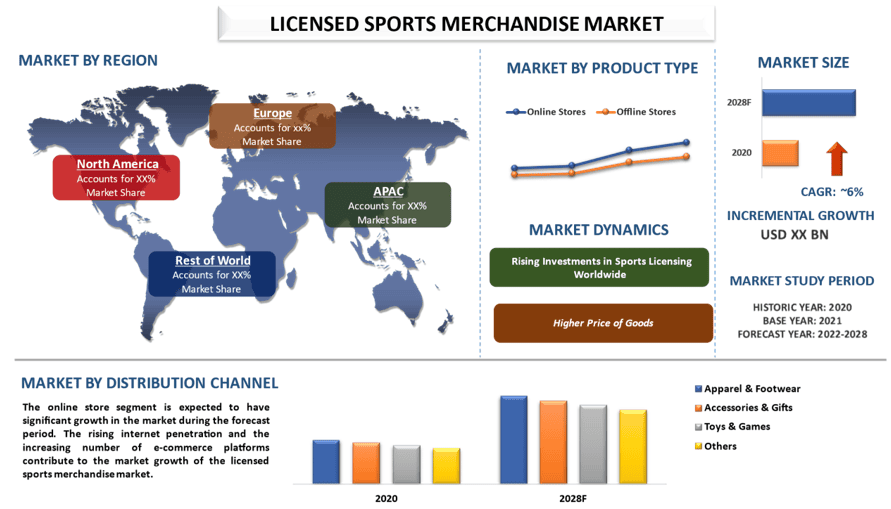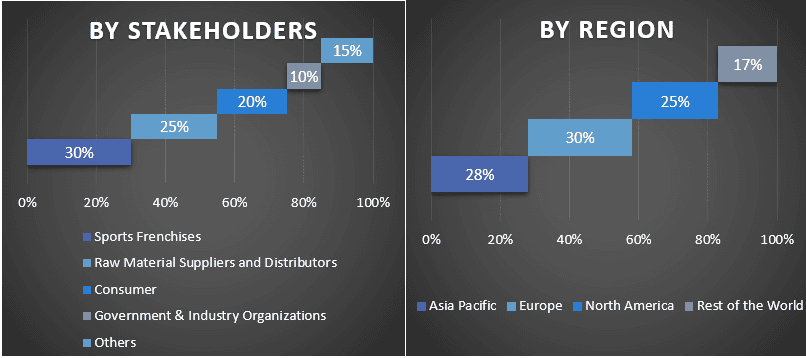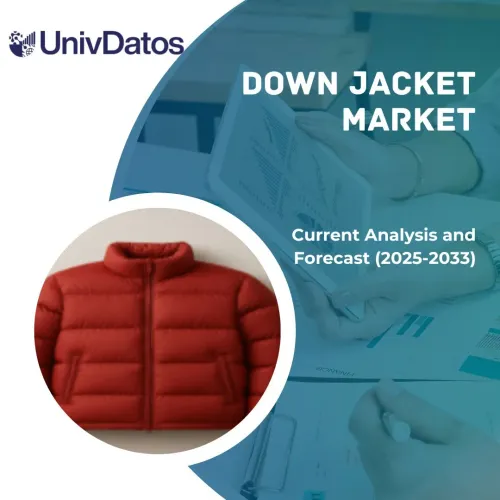- الرئيسية
- معلومات عنا
- صناعة
- الخدمات
- قراءة
- اتصل بنا
سوق البضائع الرياضية المرخصة: التحليل الحالي والتوقعات (2022-2028)
التركيز على نوع المنتج (الملابس والأحذية، والإكسسوارات والهدايا، والألعاب، وغيرها)؛ وقناة التوزيع (المتاجر الإلكترونية والمتاجر غير الإلكترونية)؛ والمنطقة (أمريكا الشمالية وأوروبا وآسيا والمحيط الهادئ وبقية العالم)؛ والمنطقة/الدولة

من المتوقع أن ينمو سوق البضائع الرياضية المرخصة العالمي بمعدل كبير يبلغ حوالي 5٪ خلال الفترة المتوقعة 2022-2028. البضائع الرياضية هي العناصر المتعلقة بأي رياضة أو نادٍ رياضي. إن تزايد شعبية الأحداث الرياضية بين الناس إلى جانب العدد المتزايد من الأندية الرياضية هي عوامل مهمة تعزز نمو البضائع الرياضية المرخصة. علاوة على ذلك، فإن العدد المتزايد من البطولات المحلية والدولية إلى جانب الطلب المتزايد على الملابس المعمرة أثناء التدريب الرياضي يحفز أيضًا نمو سوق البضائع الرياضية المرخصة.
تعتبر Adidas AG و Columbia Sportswear و Dick’s Sporting Goods Inc. و Fanatics Inc. و G-III Apparel Group Ltd. و Hanesbrands Inc. و Nike Inc. و Prada و Puma SE و Sports Direct International Plc. من بين اللاعبين الرئيسيين في السوق. وقد اضطلع هؤلاء اللاعبون بالعديد من عمليات الاندماج والاستحواذ إلى جانب الشراكات لتسهيل تزويد العملاء بمنتجات/تقنيات مبتكرة وعالية التقنية.
الرؤى المقدمة في التقرير
"من بين أنواع المنتجات، من المتوقع أن تشهد فئة الملابس والأحذية نموًا سنويًا مركبًا أعلى خلال الفترة المتوقعة"
استنادًا إلى نوع المنتج، تم تصنيف السوق إلى ملابس وأحذية وإكسسوارات وهدايا وألعاب وغيرها. من المتوقع أن تشهد فئة الملابس والأحذية نموًا سنويًا مركبًا أعلى خلال الفترة المتوقعة. الطلب على الملابس الرياضية من الناس لإظهار دعمهم لفرقهم إلى جانب زيادة استخدام الملابس والأحذية أثناء التدريب هي العوامل البارزة لنمو سوق البضائع الرياضية المرخصة.
"من بين قنوات التوزيع، من المتوقع أن تحتفظ المتاجر عبر الإنترنت بحصة كبيرة في السوق في عام 2020"
استنادًا إلى قناة التوزيع، تم تصنيف السوق إلى متاجر عبر الإنترنت ومتاجر غير متصلة بالإنترنت. من بين هؤلاء، من المتوقع أن تحتفظ المتاجر عبر الإنترنت بحصة كبيرة من السوق في عام 2020. يُعزى الطلب المتزايد على التوصيل السريع وظهور منصات التجارة السريعة إلى النمو القطاعي للمتاجر عبر الإنترنت. علاوة على ذلك، تنقل الأندية الرياضية أيضًا أعمالها إلى القناة عبر الإنترنت لتوسيع نطاق وصولها إلى الناس والمشجعين.
"من المتوقع أن تحتفظ أمريكا الشمالية بحصة كبيرة في السوق"
من أجل فهم أفضل لاعتماد السوق لصناعة البضائع الرياضية المرخصة، يتم تحليل السوق بناءً على وجوده في جميع أنحاء العالم في دول مثل أمريكا الشمالية (الولايات المتحدة وكندا وبقية أمريكا الشمالية) وأوروبا (ألمانيا وفرنسا وإيطاليا وإسبانيا والمملكة المتحدة وبقية أوروبا) وآسيا والمحيط الهادئ (الصين واليابان والهند وأستراليا وبقية منطقة آسيا والمحيط الهادئ) وبقية العالم. في عام 2020، احتلت أمريكا الشمالية حصة كبيرة من سوق البضائع الرياضية المرخصة العالمي. يُعزى ذلك أساسًا إلى وجود أندية رياضية كبرى وعدد متزايد من الأحداث الرياضية في المنطقة. علاوة على ذلك، فإن وجود بنية تحتية رياضية أفضل والتي بسببها يقدم الرياضيون أداءً أفضل في الرياضة يعزى إلى نمو اهتمام الناس بالنشاط الرياضي.
أسباب شراء هذا التقرير:
- تتضمن الدراسة تحليل لحجم السوق والتنبؤ به تم التحقق منه من قبل خبراء الصناعة الرئيسيين المعتمدين.
- يقدم التقرير مراجعة سريعة للأداء العام للصناعة في لمحة واحدة.
- يغطي التقرير تحليلًا متعمقًا لأقران الصناعة البارزين مع التركيز الأساسي على البيانات المالية الرئيسية للأعمال ومحفظة المنتجات واستراتيجيات التوسع والتطورات الأخيرة.
- فحص تفصيلي للدوافع والقيود والاتجاهات الرئيسية والفرص السائدة في الصناعة.
- تغطي الدراسة بشكل شامل السوق عبر قطاعات مختلفة.
- تحليل متعمق على المستوى الإقليمي للصناعة.
خيارات التخصيص:
يمكن تخصيص سوق البضائع الرياضية المرخصة العالمي بشكل أكبر وفقًا للمتطلبات أو أي قطاع سوق آخر. إلى جانب ذلك، تتفهم UMI أن لديك احتياجات عمل خاصة بك، لذا لا تتردد في التواصل معنا للحصول على تقرير يناسب متطلباتك تمامًا.
جدول المحتويات
منهجية البحث لتحليل سوق البضائع الرياضية المرخصة (2022-2028)
كان تحليل السوق التاريخية وتقدير السوق الحالية والتنبؤ بالسوق المستقبلية لسوق البضائع الرياضية المرخصة العالمي هي الخطوات الرئيسية الثلاث التي تم اتخاذها لإنشاء وتحليل اعتماد البضائع الرياضية المرخصة في المناطق الرئيسية على مستوى العالم. تم إجراء بحث ثانوي شامل لجمع أرقام السوق التاريخية وتقدير حجم السوق الحالي. ثانيًا، للتحقق من صحة هذه الرؤى، تم أخذ العديد من النتائج والافتراضات في الاعتبار. علاوة على ذلك، تم إجراء مقابلات أولية شاملة أيضًا مع خبراء الصناعة عبر سلسلة القيمة لسوق البضائع الرياضية المرخصة العالمي. بعد افتراض أرقام السوق والتحقق من صحتها من خلال المقابلات الأولية، استخدمنا نهجًا من أعلى إلى أسفل / من أسفل إلى أعلى للتنبؤ بحجم السوق بالكامل. بعد ذلك، تم اعتماد طرق تقسيم السوق وتثليث البيانات لتقدير وتحليل حجم سوق القطاعات والقطاعات الفرعية التي تنتمي إليها الصناعة. تم شرح المنهجية التفصيلية أدناه:
تحليل حجم السوق التاريخي
الخطوة 1: دراسة متعمقة للمصادر الثانوية:
تم إجراء دراسة ثانوية تفصيلية للحصول على حجم السوق التاريخي لسوق البضائع الرياضية المرخصة من خلال مصادر الشركة الداخلية مثل التقارير السنوية والبيانات المالية وعروض الأداء والنشرات الصحفية وما إلى ذلك، والمصادر الخارجية بما في ذلك المجلات والأخبار والمقالات والمنشورات الحكومية ومنشورات المنافسين وتقارير القطاعات وقاعدة بيانات الطرف الثالث والمنشورات الموثوقة الأخرى.
الخطوة 2: تقسيم السوق:
بعد الحصول على حجم السوق التاريخي لسوق البضائع الرياضية المرخصة، أجرينا تحليلًا ثانويًا مفصلاً لجمع رؤى السوق التاريخية ومشاركتها لمختلف القطاعات والقطاعات الفرعية للمناطق الرئيسية. يتم تضمين القطاعات الرئيسية في التقرير كنوع القطاع والتطبيق. علاوة على ذلك، تم إجراء تحليلات على مستوى الدولة لتقييم الاعتماد الكلي لنماذج الاختبار في تلك المنطقة.
الخطوة 3: تحليل العوامل:
بعد الحصول على حجم السوق التاريخي للقطاعات والقطاعات الفرعية المختلفة، أجرينا تحليلًا تفصيليًا للعوامل لتقدير حجم السوق الحالي لسوق البضائع الرياضية المرخصة. علاوة على ذلك، أجرينا تحليلًا للعوامل باستخدام متغيرات تابعة ومستقلة مثل نوع المنتج وقناة التوزيع للبضائع الرياضية المرخصة. تم إجراء تحليل شامل لسيناريوهات الطلب والعرض مع الأخذ في الاعتبار أهم الشراكات وعمليات الاندماج والاستحواذ والتوسع التجاري وإطلاق المنتجات في قطاع سوق البضائع الرياضية المرخصة في جميع أنحاء العالم.
تقدير حجم السوق الحالي والتنبؤ به
تحديد حجم السوق الحالي: بناءً على رؤى قابلة للتنفيذ من الخطوات الثلاث المذكورة أعلاه، توصلنا إلى حجم السوق الحالي واللاعبين الرئيسيين في سوق البضائع الرياضية المرخصة العالمي والحصص السوقية للقطاعات. تم تحديد جميع النسب المئوية المطلوبة وتقسيمات السوق باستخدام النهج الثانوي المذكور أعلاه وتم التحقق منها من خلال المقابلات الأولية.
التقدير والتنبؤ: لتقدير السوق والتنبؤ بها، تم تخصيص أوزان لعوامل مختلفة بما في ذلك المحركات والاتجاهات والقيود والفرص المتاحة لأصحاب المصلحة. بعد تحليل هذه العوامل، تم تطبيق تقنيات التنبؤ ذات الصلة، أي النهج من أعلى إلى أسفل / من أسفل إلى أعلى للوصول إلى توقعات السوق لعام 2028 لمختلف القطاعات والقطاعات الفرعية عبر الأسواق الرئيسية على مستوى العالم. تشمل منهجية البحث المعتمدة لتقدير حجم السوق ما يلي:
- حجم سوق الصناعة، من حيث الإيرادات (بالدولار الأمريكي) ومعدل اعتماد سوق البضائع الرياضية المرخصة عبر الأسواق الرئيسية محليًا
- جميع الحصص المئوية وتقسيمات وانهيارات قطاعات السوق والقطاعات الفرعية
- اللاعبون الرئيسيون في سوق البضائع الرياضية المرخصة العالمي من حيث المنتجات المعروضة. أيضًا، استراتيجيات النمو التي يتبناها هؤلاء اللاعبون للتنافس في السوق سريع النمو
التحقق من حجم السوق وحصته
البحث الأولي: تم إجراء مقابلات متعمقة مع قادة الرأي الرئيسيين (KOLs) بما في ذلك كبار المديرين التنفيذيين (CXO/VPs، رئيس قسم المبيعات، رئيس قسم التسويق، الرئيس التشغيلي، الرئيس الإقليمي، رئيس الدولة، وما إلى ذلك) عبر المناطق الرئيسية. ثم تم تلخيص نتائج البحث الأولي وإجراء تحليل إحصائي لإثبات الفرضية المذكورة. تم دمج المدخلات من البحث الأولي مع النتائج الثانوية، وبالتالي تحويل المعلومات إلى رؤى قابلة للتنفيذ.
تقسيم المشاركين الأساسيين في مناطق مختلفة

هندسة السوق
تم استخدام تقنية تثليث البيانات لإكمال تقدير السوق الإجمالي وللوصول إلى أرقام إحصائية دقيقة لكل قطاع وقطاع فرعي من سوق البضائع الرياضية المرخصة العالمي. تم تقسيم البيانات إلى عدة قطاعات وقطاعات فرعية بعد دراسة معايير واتجاهات مختلفة في مجالات نوع المنتج وقناة التوزيع في سوق البضائع الرياضية المرخصة العالمي.
الهدف الرئيسي لدراسة سوق البضائع الرياضية المرخصة العالمي
تم تحديد اتجاهات السوق الحالية والمستقبلية لسوق البضائع الرياضية المرخصة العالمي في الدراسة. يمكن للمستثمرين الحصول على رؤى استراتيجية لترسيخ تقديرهم للاستثمارات على التحليل النوعي والكمي الذي تم إجراؤه في الدراسة. حددت اتجاهات السوق الحالية والمستقبلية الجاذبية الإجمالية للسوق على المستوى الإقليمي، مما يوفر منصة للمشارك الصناعي لاستغلال السوق غير المستغل للاستفادة من ميزة الميزة الأولى. تشمل الأهداف الكمية الأخرى للدراسات ما يلي:
- تحليل حجم السوق الحالي والمتوقع لسوق البضائع الرياضية المرخصة من حيث القيمة (بالدولار الأمريكي). أيضًا، قم بتحليل حجم السوق الحالي والمتوقع للقطاعات والقطاعات الفرعية المختلفة
- تشمل القطاعات في الدراسة مجالات نوع المنتج والتوزيع.
- تحديد وتحليل الإطار التنظيمي لصناعة البضائع الرياضية المرخصة.
- تحليل سلسلة القيمة المتضمنة في وجود وسطاء مختلفين، إلى جانب تحليل سلوكيات العملاء والمنافسين في الصناعة.
- تحليل حجم السوق الحالي والمتوقع لسوق البضائع الرياضية المرخصة للمنطقة الرئيسية.
- تشمل الدول الرئيسية في المناطق التي تمت دراستها في التقرير منطقة آسيا والمحيط الهادئ وأوروبا وأمريكا الشمالية وبقية العالم.
- ملفات تعريف الشركات لسوق البضائع الرياضية المرخصة واستراتيجيات النمو التي يتبناها اللاعبون في السوق للاستمرار في السوق سريع النمو
- تحليل متعمق على المستوى الإقليمي للصناعة
ذات صلة التقارير
العملاء الذين اشتروا هذا المنتج اشتروا أيضًا










